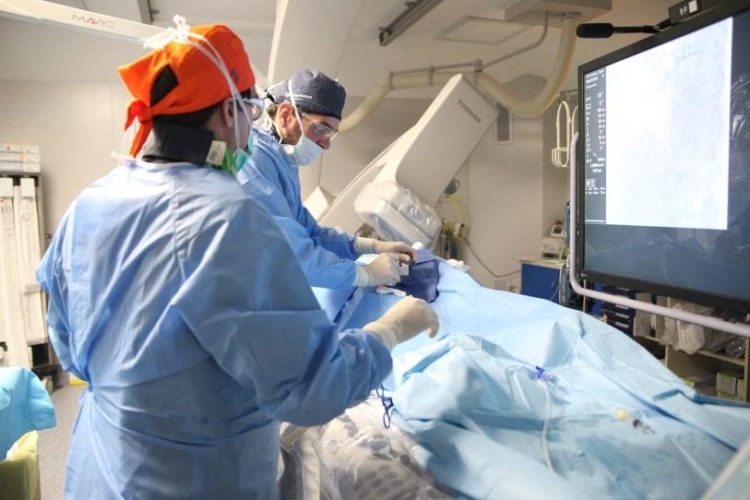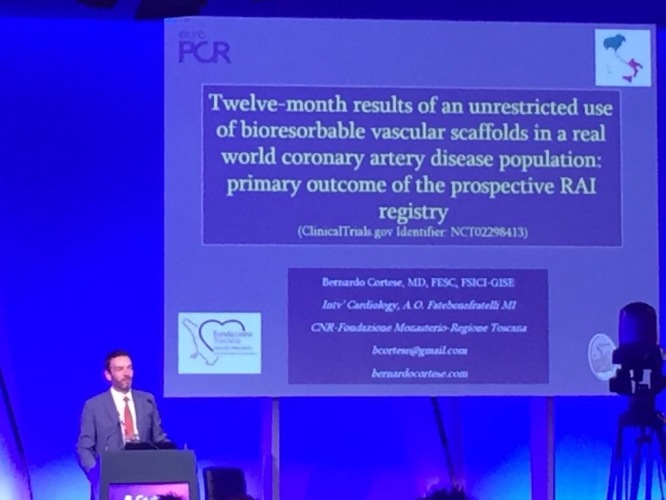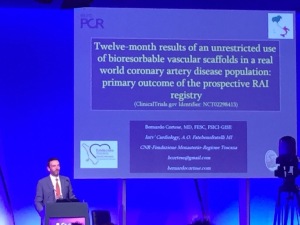We are proud to share the first Italian implantation at our center, of this new-generation BRS technology, a few weeks ago.

Reva Fantom coronary scaffold-FIRST implantation in Italy

Twelve-month results of an unrestricted use of bioresorbable vascular scaffolds in a real world coronary artery disease population: primary outcome of the prospective RAI registry
During the EuroPCR 2017, I presented the results of the first year of Follow-Up for the RAI Registry, a spontaneous, multicenter, prospective data collection on consecutive patients undergoing BVS implantation in Italy.
The Objective of the Registry is to evaluate the long-term safety and efficacy of Absorb BVS within an unrestricted cohort of patients undergoing PCI. There have been enrolled 1505 Patients in 25 Italian Centers.

Conclusion
•The RAI registry represents a real world, contemporary
BVS population, with very few exclusion criteria.
• The population enrolled is extremely well treated
(predilatation, postdilatation).
• Current-era BVS use, according to specific and
standardized techniques of implantation, show good
clinical outcome in an unrestricted patient population at
mid-term follow up.
Here’s the presentation of the meeting
2 RAI 12m
International Journal of Cardiology – Treatment of bifurcation lesions with drug-coated balloons: A review of currently available scientificdata
This is the article published in the International Journal of Cardiology 220 (2016) 589–594.
International Journal of Cardiology – Treatment of bifurcation lesions with drug-coated balloons: A review of currently available scientificdata
Bernardo Cortese (a,b,⁎), Davide Piraino (c), Dario Buccheri (a,c), Fernando Alfonso(d)
(a) Interventional Cardiology, A.O. Fatebenefratelli Milano, Italy
(b) Fondazione Monasterio CNR-Regione Toscana, Italy
(c) Interventional Cardiology,“P.Giaccone”Universitary Hospital of Palermo, Italy
(d) Interventional Cardiology, Hospital Universitario de La Princesa, Spain
(⁎) Corresponding author at: Interventional Cardiology, A.O. Fatebenefratelli Milano, Bastioni di Porta Nuova 21, 20100 Milano, Italy. E-mail address:bcortese@gmail.com (B. Cortese)
Conclusion
DCB use for bifurcation lesion management remains very attractive indeed as a complement of a provisional stenting strategy. However, currently available scientific evidence remains scarce and we still require additional data to refine its real clinical value. However, an indiscriminate use of stents in this setting (complex stenting or any 2-stent technique) is associated with suboptimal Clinical and angiographic results. The use of a novel generation DES in the MB remains the strategy of choice for most patients that can be managed with a provisional stenting strategy. It is possible that newer technologies such as DCB and biovascular scaffolds might improve the short and long-term outcome of bifurcation lesions, allowing a limited use of permanent prosthesis, especially at the SB

International Journal of Cardiology – Biovascular scaffolds and reversible coronary aneurysm
This is the article published in the International Journal of Cardiology 214 (2016) 225–227.
Biovascular scaffolds and reversible coronary aneurysm
Bernardo Cortese (a,⁎), Pedro Silva Orrego (a), Kazuyuki Yahagi (b), Renu Virmani(b)
(a) Interventional Cardiology, A.O. Fatebenefratelli Milano, Italy
(b) CVPath Institute, Gaithersburg, MD, USA
(⁎) Corresponding author at: Interventional Cardiology, A.O. Fatebenefratelli Milano, Bastioni di Porta Nuova 21, 20100 Milano, Italy. E-mail address:bcortese@gmail.com (B. Cortese)
Conclusion
Late acquired scaffold malapposition is a possible complication, whose mechanism and clinical consequences are not yet definitely addressed. However, the natural fate of resorption with inflammation resulting in aneurysm and ectasia with subsequent healing of the currently available BVS could be responsible for the temporary nature of this phenomenon.
Supplementary data to this article can be found online at http://dx.doi.org/10.1016/j.ijcard.2016.03.167

DCB GIC 2017 – Nuove tecnologie e applicazioni per il pallone medicato nel 2017
This is the article published in G Ital Cardiol 2017.
Nuove tecnologie e applicazioni per il pallone medicato nel 2017
Bernardo Cortese (1,2), Gaetano Di Palma (1), Roberto Nerla (3), Antonio Micari (3)
(1) Cardiologia Interventistica, ASST Fatebenefratelli-Sacco, Milano
(2) U.O. Cardiologia Diagnostica e Interventistica, Fondazione “Gabriele Monasterio”-Regione Toscana-CNR, Massa
(3) Laboratorio di Cardio-Angiologia Diagnostica e Interventistica, Maria Cecilia Hospital, Cotignola (RA)
Conclusioni
I DCB sono in grado di superare alcune importanti limitazioni degli stent senza perdere la capacità di inibizione della proliferazione neo-intimale, ma deve essere chiaro che questi costituiscono una componente della strategia di rivascolarizzazione ottimale per i nostri pazienti, sempre più complessi, piuttosto che un’alternativa ai DES. Mentre il loro ruolo nella ISR è ormai ben definito, il trattamento di lesioni de novo, specie nel distretto coronarico, è la nuova frontiera e presenta ad oggi dati incoraggianti, ancorché preliminari. In ambito periferico, tali risultati sembrano non subire effetto di catch-upa 2-3 anni e si possono estendere sia a lesioni TASC A/B sia alle più complesse TASC C/D, così come alle sottopopolazioni di pazienti con lesioni severamente calcifiche, dove l’aterectomia costituisce un valido alleato del DCB, o la ISR.
I diversi DCB attualmente in commercio differiscono per la tecnologia che ne è alla base e, pertanto, hanno fornito risultati differenti in termini di efficacia a lungo termine, il che suggerisce l’assenza di un “effetto di classe” per i DCB in generale. Ogni differente tecnologia ha l’obbligo di dimostrare la sua efficacia e sicurezza in studi di adeguata ampiezza, qualità e rigore che possano confermare l’utilità nella pratica clinica dei dispositivi che entreranno in commercio da qui in avanti.

